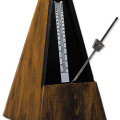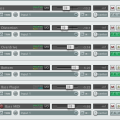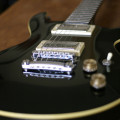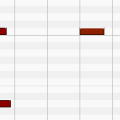This is the third and final part of a series. You’ll find the previous parts here:
Writing Your First Song Part I: Creating Riffs
Writing Your First Song Part II: Recording and Arranging
The Other Instruments
 Having recorded your guitar tracks and decided the order of the different parts you are ready to put them together into a song. Things that are obviously missing are the tracks for the other instruments, for metal usually drums and bass. I have access to neither a live drummer or a bass player, so I use the next best thing: virtual instruments.
Having recorded your guitar tracks and decided the order of the different parts you are ready to put them together into a song. Things that are obviously missing are the tracks for the other instruments, for metal usually drums and bass. I have access to neither a live drummer or a bass player, so I use the next best thing: virtual instruments.
For drums I use Superior Drummer, a very cool drum plugin from Swedish software studio Toontrack. Most of you probably know of it. One of the coolest things about it is that they’ve had really good drummers record every single part of the drumkit, hit in usually three different ways (like center, off-center rim for snares) at a bunch of different strengths. So if you take down velocity on a snare, it doesn’t just use the same sample at a lower volume, it uses a whole different sample. So a drumkit in SD can consist of something like 1000 samples.
I’m going to write a separate post about programming drum tracks later on, but some basics belong here. I usually create one basic drum pattern per part – one for the verse, on for the prechorus, one for the chorus etc. Rather than start from one of the prefabricated patterns shipped with the drum plugin (which I often use in the previous phase, when trying to arrange the song), I start over fresh. I’m always looking to get the drums to reinforce the riffs of the guitar tracks.
With bass it’s pretty much the same. I program the bass using MIDI that is rendered by a plugin. The plugin I use is Cakewalk Studio Instruments Bass. For its price it’s quite decent, but it completely lacks the finesse of Superior Drummer’s adaptive sample selection etc. For that you’d get Trillian, which I’m probably going to get later on.
I create one basic bass pattern per part. Since I’m no bassist, I usually let the guitars be the guide and create the MIDI pattern for the bass that follows the rhythm guitars pretty closely, sometimes a bit simplified for faster riffs.
This is actually pretty much what you want in metal. The bass is supposed to be a third guitar that provides the bottom end. For other types of music the bass can be the sole melodic rhythm instrument, and that would probably result in pretty different patterns.
Arranging the Guitar Tracks
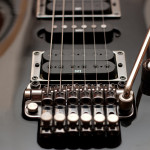 I often start putting the final song together before I have good enough complete guitar tracks recorded. One reason for this is that I have a lot more computer time available than I have guitar time. I often start out with half recordings that were done too early since didn’t have time to practice the riffs enough.
I often start putting the final song together before I have good enough complete guitar tracks recorded. One reason for this is that I have a lot more computer time available than I have guitar time. I often start out with half recordings that were done too early since didn’t have time to practice the riffs enough.
Another is that I’m usually anxious to try out different variants of the song arrangment. So there’s a lot of cutting and pasting going on in this phase. That’s fine, for the finished song I re-record all the guitar parts.
Mixing
I’m not going to go into great deals of detail on mixing, since I’m not very good at it (at least not yet). I would really recommend you read WDYRSLA and Emrz’s book Systematic Mixing Guide. But I’ll provide some basic tips anyway.
For me mixing is all about separation and coherence. You want to separate all your instruments clearly so that they don’t interfere with each other and create mud. You accomplish this by separating the tracks’ frequency spectrums by using EQ to cut away parts that would collide. You also have panning at your disposal, to create a lateral separation.
The other goal is coherence, to make the tracks form parts of a whole. Your most important tools here are matching the volume of the tracks and EQ:ing away things that stand out too much. Carefully applied reverb can provide the illusion that all tracks were recorded in the same space and glue the tracks together.
I always double track rhythm guitars. I record two tracks as identical as I can get them and pan them hard left and right. This makes them sound bigger and also leaves room in the middle for lead guitars and other instruments. I cut pretty hard high-passing somewhere between 70 and 100 Hz, and low-pass somewhere around 11 kHz. If there’s time I also try to pinpoint artifacts and missounds and filter them out with narrow-band notches. For a rock song I might apply some reverb, for metal that usually just clogs up the sound. Lead guitars usually get both reverb and delay.
I split the bass track in two, and on the second track I add some distortion with a guitar amp sim. The original track provides the low end and the distorted parallel track makes it meld better with the guitars. Both tracks are panned center. After just having read the Systematic Mixing chapter on bass, I’ll probably do three parallel tracks from now on, separating them more with EQ.
The drums I don’t EQ much, I more commonly go with one of the presets depending on genre. Ola Englund’s Superior preset is good, although I usually crank up the overhead mics a bit to get more cymbals and just a little more room. For rock songs I’d use some other presets with more overhead volume and maybe add some reverb. If the kick and snare don’t make it through the guitars I add some parallel compression to get more punch.
The mixing part can actually drive you a bit crazy. You probably don’t have access to a prepared room and professional perfect studio monitors. Like me you probably have a study or just your bedroom and some decent hobby-level monitors. Try your mix in as many environments you can. So you switch around between monitors, hifi speakers and different headphones to find the mix that sounds good in all of them and it’s just endless tweaking. At some point you just decide it’s as good as it’s going to get and call it quits (no guarantee you won’t go back later though).
Finishing the Song
After the fundamental mix is done I start embellishing things.
For drums I add small variations to the patterns and fills. Sometimes I steal fills from the repositories like EZ Drummer’s, but mostly I make my own. I can take quite a bit of dabbling in the MIDI editor to get good fills, there’s usually a number of exports of the song and listening to it with the new drum patterns in bed or on my way to work.
For guitars the embellishment is adding lead parts. The solo is usually done before the mixing stage, but other small lead stuff gets added last. There might be a pedal melody riff allng with the chorus, a lead variation of the verse riff etcetera. Sometimes I solo the guitars for one bar for dramatic effect, sometimes I add a harmony to a part of the rhythm.
These are all small things but do a lot for the overall feeling of the end result. Just as with mixing it’s hard to know when to stop – just adding more stuff will not make the song better and better.
Finally, to compete a little with professional grade tracks, I use a limiter on the master track. A good one is TLS Limiter.
What Do I Do With It?
Once the song is done – what’s the next step? If you’re working on an album it’s probably obvious. If not, I’d recommend putting it on SoundCloud. It’s a great way of hosting your songs and getting some feedback, and you can add your tracks to groups for more exposure. SoundCloud also provides excellent embedding features for blogs, forums and Facebook.
Here’s the final version (?) of the song I’ve been working on in the two previous posts in this series. I’m quite happy with it considering it’s my second fully finished song.
[soundcloud id=’41236024′]

